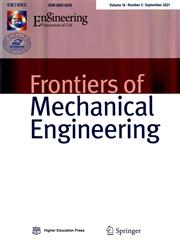Lunar plume-surface interactions using rarefiedMultiphaseFoam
IF 4
2区 工程技术
Q1 ENGINEERING, MECHANICAL
引用次数: 0
Abstract
Understanding plume-surface interactions is essential to the design of lander modules and potential bases on bodies such as the Moon, as it is important to predict erosion patterns on the surface and the transport of the displaced regolith material. Experimentally, it is difficult to replicate the extra-terrestrial conditions (e.g. the effects of reduced gravity). Existing numerical tools have limited accessibility and different levels of sophistication in the modelling of regolith entrainment and subsequent transport. In this work, a fully transient open source code for solving rarefied multiphase flows, rarefiedMultiphaseFoam, is updated with models to account for solid-solid interactions and applied to rocket exhaust plume-lunar regolith interactions. Two different models to account for the solid-solid collisions are considered; at relatively low volume fractions, a stochastic collision model, and at higher volume fractions the higher fidelity multiphase particle-in-cell (MPPIC) method. Both methods are applied to a scaled down version of the Apollo era lunar module descent engine and comparisons are drawn between the transient simulation results. It is found that the transient effects are important for the gas phase, with the shock structure and stand-off height changing as the regolith is eroded by the plume. Both models predict cratering at early times and similar dispersion characteristics as the viscous erosion becomes dominant. In general, the erosion processes are slower with the multiphase particle-in-cell method because it accounts for more physical effects, such as enduring contacts and a maximum packing limit. It is found that even if the initial volume fraction is low, the stochastic collision method can become unreliable as the plume impinges on the surface and compresses the regolith particles, invalidating the method’s assumption of only binary collisions. Additionally, it is shown that the breakdown of the locally free-molecular flow assumption that is used to calculate the drag and heat transfer on the solid particles has a strong influence on the temperatures that the solid particles obtain.利用稀土多相泡沫研究月球羽状表面相互作用
了解羽流与地表的相互作用对于着陆器模块的设计和月球等天体上潜在基地的设计至关重要,因为它对预测地表的侵蚀模式和迁移的风化层物质的运输非常重要。在实验上,很难复制地外环境(例如重力降低的影响)。现有的数值工具的可及性有限,而且在模拟风化带夹带和随后的搬运方面的复杂程度不同。在这项工作中,一个用于求解稀薄多相流的完全瞬态开源代码,rarefiedMultiphaseFoam,被更新为考虑固体-固体相互作用的模型,并应用于火箭排气羽流-月球风化层相互作用。考虑了两种不同的模型来解释固体-固体碰撞;在相对较低的体积分数下,采用随机碰撞模型,而在较高的体积分数下,采用保真度更高的多相粒子池(MPPIC)方法。将这两种方法应用于阿波罗时代登月舱下降发动机的缩小版,并对瞬态模拟结果进行了比较。发现瞬态效应对气相很重要,随着风化层被羽流侵蚀,激波结构和分离高度发生变化。两种模型都预测了早期的陨石坑和相似的分散特征,因为粘性侵蚀占主导地位。一般来说,多相颗粒电池法的侵蚀过程较慢,因为它考虑了更多的物理效应,如持久接触和最大堆积限制。研究发现,即使初始体积分数较低,随机碰撞方法也会变得不可靠,因为羽流撞击表面并压缩风化层颗粒,从而使该方法只发生二元碰撞的假设失效。此外,还表明,用于计算固体颗粒的阻力和传热的局部自由分子流假设的破坏对固体颗粒获得的温度有很强的影响。
本文章由计算机程序翻译,如有差异,请以英文原文为准。
求助全文
约1分钟内获得全文
求助全文
来源期刊

Frontiers of Mechanical Engineering
Engineering-Mechanical Engineering
CiteScore
7.20
自引率
6.70%
发文量
731
期刊介绍:
Frontiers of Mechanical Engineering is an international peer-reviewed academic journal sponsored by the Ministry of Education of China. The journal seeks to provide a forum for a broad blend of high-quality academic papers in order to promote rapid communication and exchange between researchers, scientists, and engineers in the field of mechanical engineering. The journal publishes original research articles, review articles and feature articles.
 求助内容:
求助内容: 应助结果提醒方式:
应助结果提醒方式:


